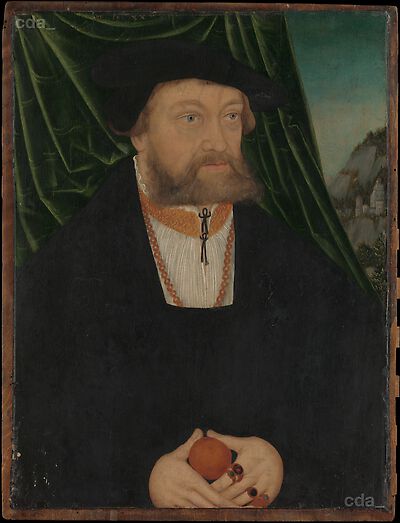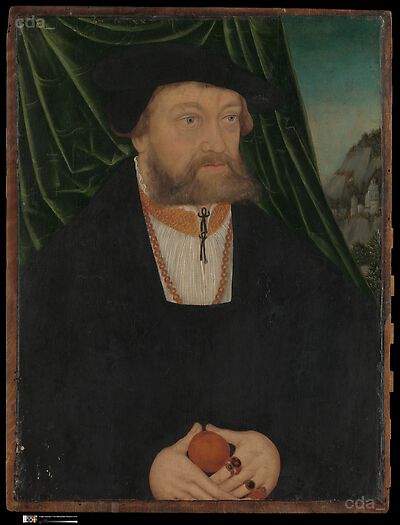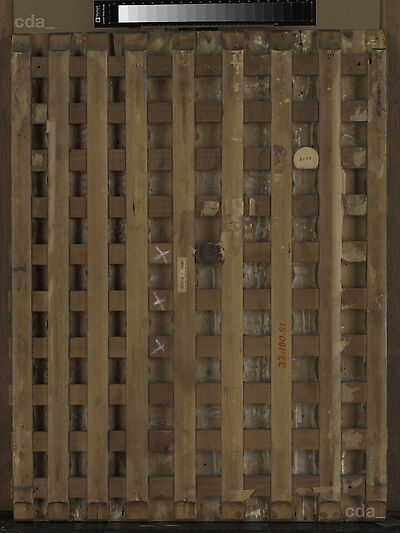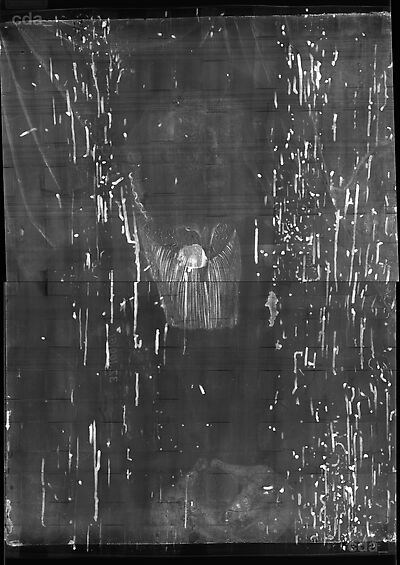This half-length portrait dated 1538 shows a man forty-five years of age.[1] He is seated before a dark green curtain that is drawn back from the right to reveal a castle on a rocky crag. His black coat opens at the chest, showing a white, pleated undershirt embroidered with gold
This half-length portrait dated 1538 shows a man forty-five years of age.[1] He is seated before a dark green curtain that is drawn back from the right to reveal a castle on a rocky crag. His black coat opens at the chest, showing a white, pleated undershirt embroidered with gold at the neck and fastened with two black bows. A gold chain necklace is tucked beneath his black shirt. Several rings adorn his left
hand, including a signet ring displaying a coat of arms with a sunburst and initials in mirror image that appear to read MLD (fig. 71).[2]
The coat-of-arms has not been identified. The black cap with earflaps suggests that he was a scholar; the D in his initials may refer to a doctoral degree.[3] Citrus fruits like the orange in the sitter's hands were luxury items at the time and could convey social distinction in portraits; in the Christian context they bore connotations of purity, fertility, and eternal life meanings that could carry over into secular portraiture.[4] If the present work had a female pendant, which is quite possible, the orange as a symbol of fertility would have been especially appropriate.[5]
[1] The date of 1537 given in Friedländer and J. Rosenberg 1978, p. 162, no. Sup 17, omits the last numeral in the abraded date inscription. On the sitter's age, see note 1 under inscription.
[2] For other examples of portraits with mirror-image initials on signet rings, see Bernhard Strigel, Hans Roth, 1527, National Gallery of Art, Washington [Hand, Cat. Washington 1993, 167-173, fig. 1]; and Barthel Bruyn the Elder, Peter Heyman, ca. 1540-45, Städel Museum, Frankfurt (Bodo Brinkmann in Brinkmann and Kemperdick, Cat. Frankfurt 2005, 85-92, figs. 64, 70].
[3] See, for example, the initials HSD (for Heinrich Stromer, Doctor) on the background and, in mirror image, on the signet ring of Heinrich Stromer, a portrait of 1527 by the same artist (private collection; [Friedländer, Rosenberg 1978, 162, no. Sup 16]; See also Dieter Koepplin in [Exhib. Cat. Basel 1974, vol. 2, p. 693, no. 617].
[4] See Kepetzis 2011, especially p. 138.
[5] For a portrait pair with an orange held by the male sitter, see Bernhard Strigel, Hans Roth and Margarethe Vöhlin, 1527, National Gallery of Art, Washington [Hand, Cat. Washington 1993, 167-173, Fig.].
[Cat. New York 2013, 88, 292, No. 19]
- Attribution
- Circle of Lucas Cranach the Elder
Attribution
| Circle of Lucas Cranach the Elder | [Cat. New York 2013, 88, No. 19] |
- Production date
- 1538
Production date
| 1538 | [datiert] |
- Dimensions
- Dimensions of support: 55.9 × 42.4 × 0.64 cm (22 × 16 11/16 × 1/4 in.)
Dimensions
Dimensions of support: 55.9 × 42.4 × 0.64 cm (22 × 16 11/16 × 1/4 in.)
Dimensions of painted surface: 53.3 × 40 cm (21 × 15 3/4 in.)
[Cat. New York 2013, 88, No. 19]
- Inscriptions and Labels
Inscribed and dated at top, left of centre:
'm.d.xxxviii / xlv'[1][1] The last few numerals in the …
Inscriptions and Labels
Inscriptions, Badges:
Inscribed and dated at top, left of centre:
'm.d.xxxviii / xlv'[1]
[1] The last few numerals in the first line and all those in the second are heavily abraded. The first line gives the date of the painting, the second probably the sitter's age of forty-five.
[Cat. New York 2013, 88, 292, No. 19]
Heraldry / emblems:
- on signet ring on index finger of left hand:
green shield charged with an orange sunburst, surmounted by initials 'm[?]ld' in mirror image
[Cat. New York 2013, 88, No. 19]
Stamps, Seals, Labels:
Reverse of the panel: (on cradle):
- in centre:
in red wax on paper, unidentified collector's seal
- at upper right:
in pen and ink on round paper decal, '6080'
- at upper centre and right:
stamped four times in ink, 'douane' [...]
- at lower centre:
stamped in ink, jpl / [...] 01 [...]
- left of centre:
letterpress-printed on paper, imported from France
- left of centre:
in white chalk, xxx
- at centre right:
in red paint, 32.100.61
[Cat. New York 2013, 88, No. 19]
- Owner
- The Metropolitan Museum of Art, New York
- Repository
- The Metropolitan Museum of Art, New York
- Location
- New York
- CDA ID
- US_MMANY_32-100-61
- FR (1978) Nr.
- FRSup017
- Persistent Link
- https://lucascranach.org/en/US_MMANY_32-100-61/



